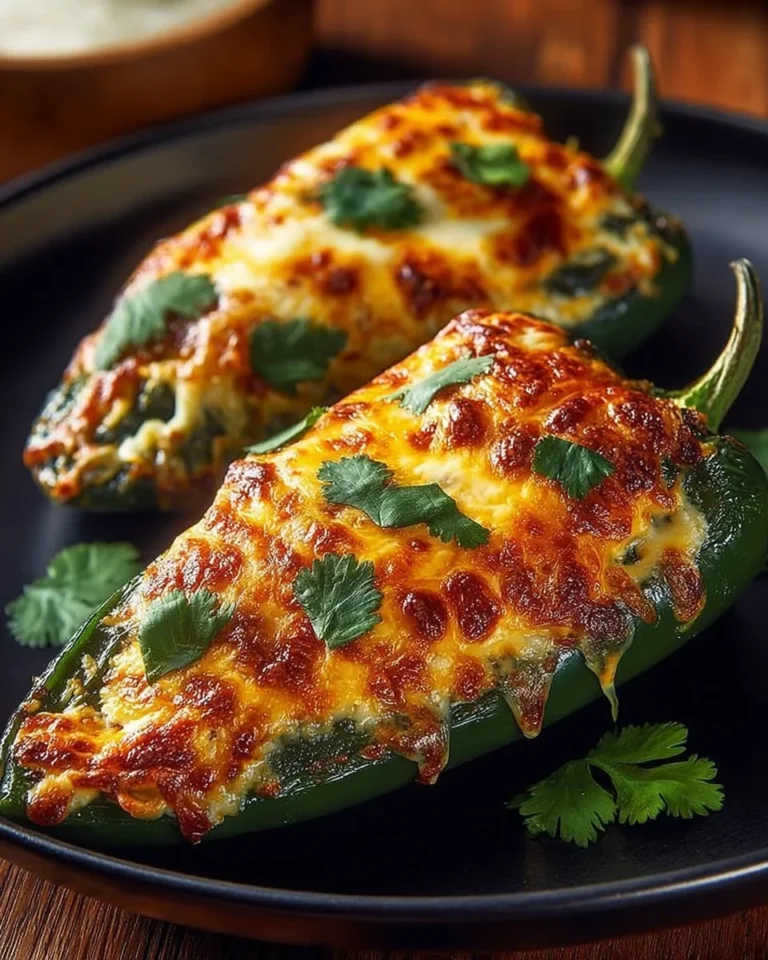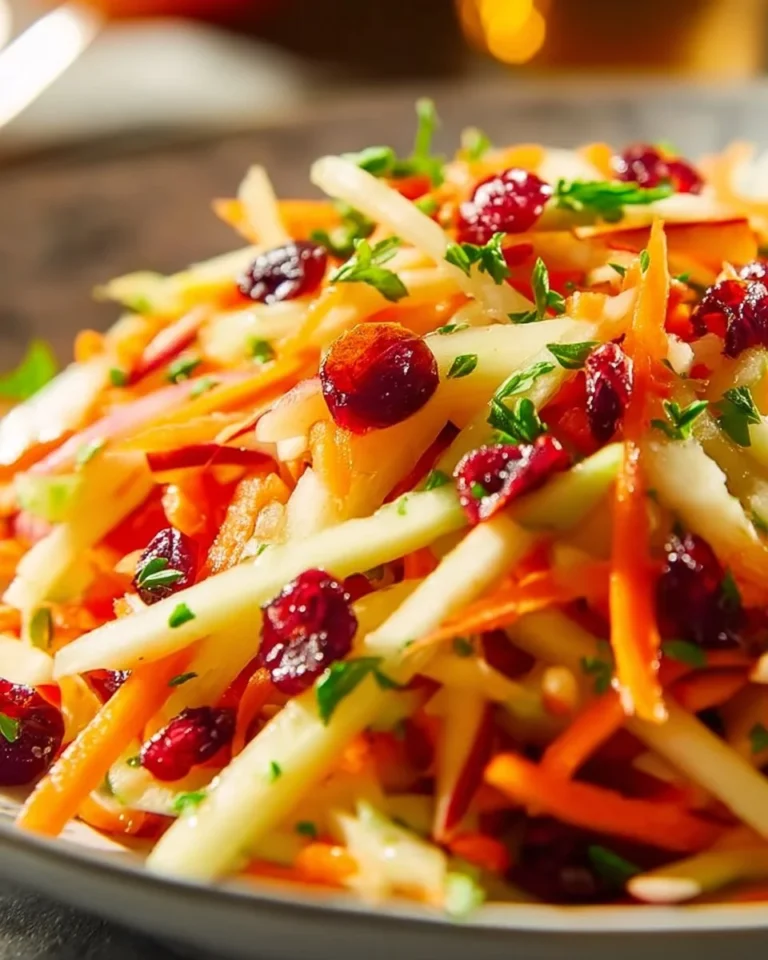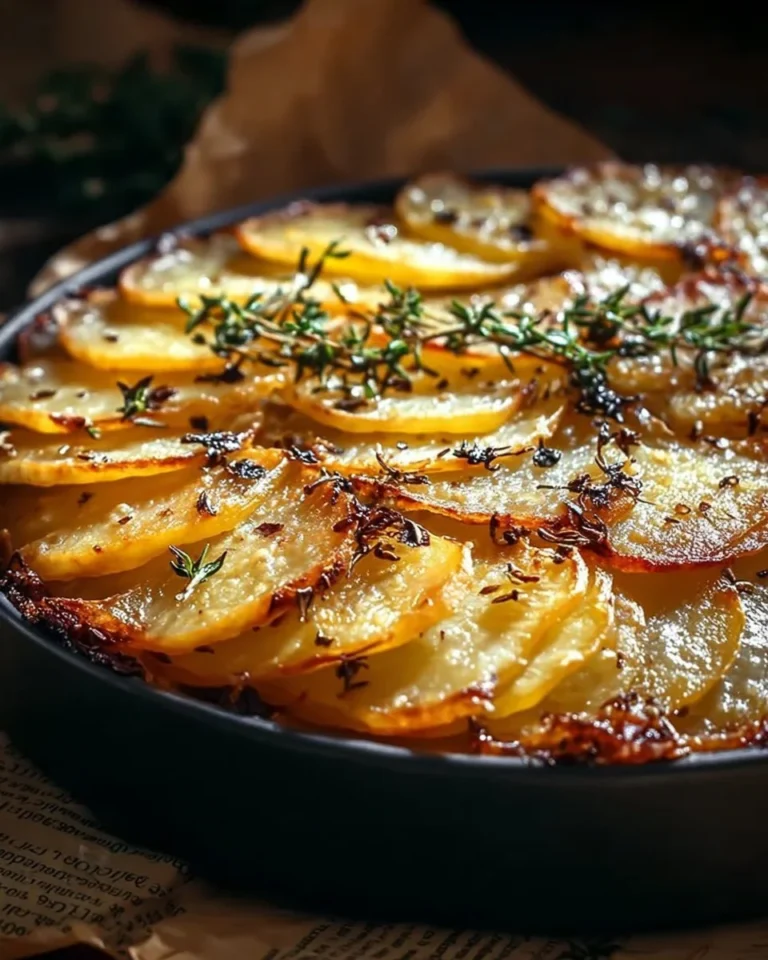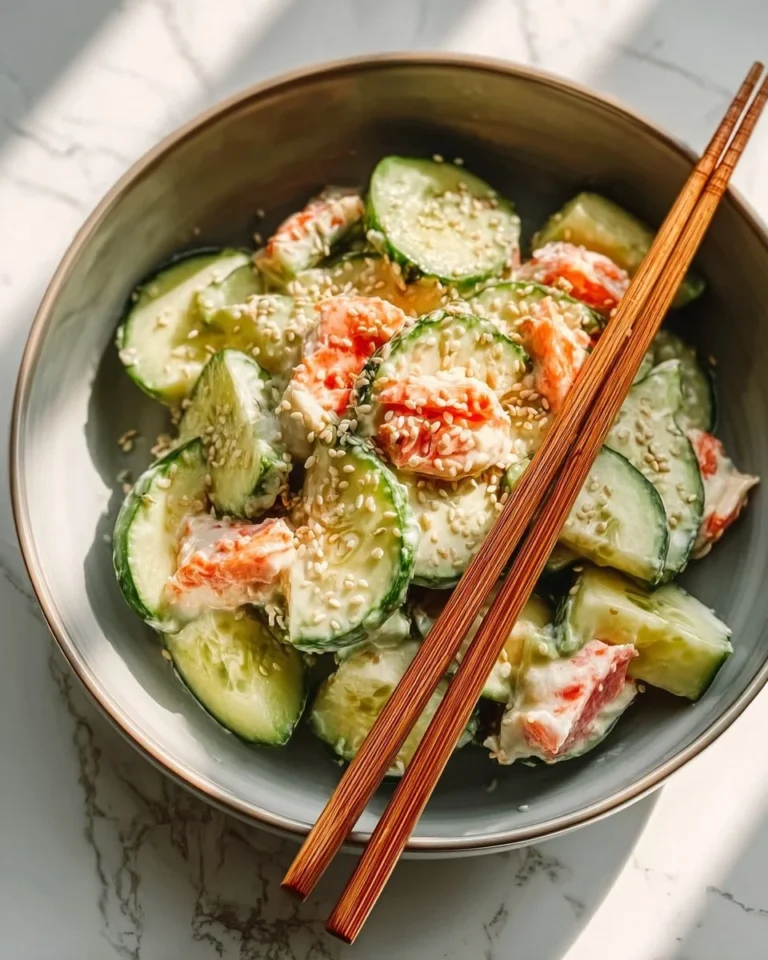Imagine turning simple vegetables into a feast with a few aromatic spices and roasting. Indian Spiced Roasted Vegetables are not just tasty but also good for you.
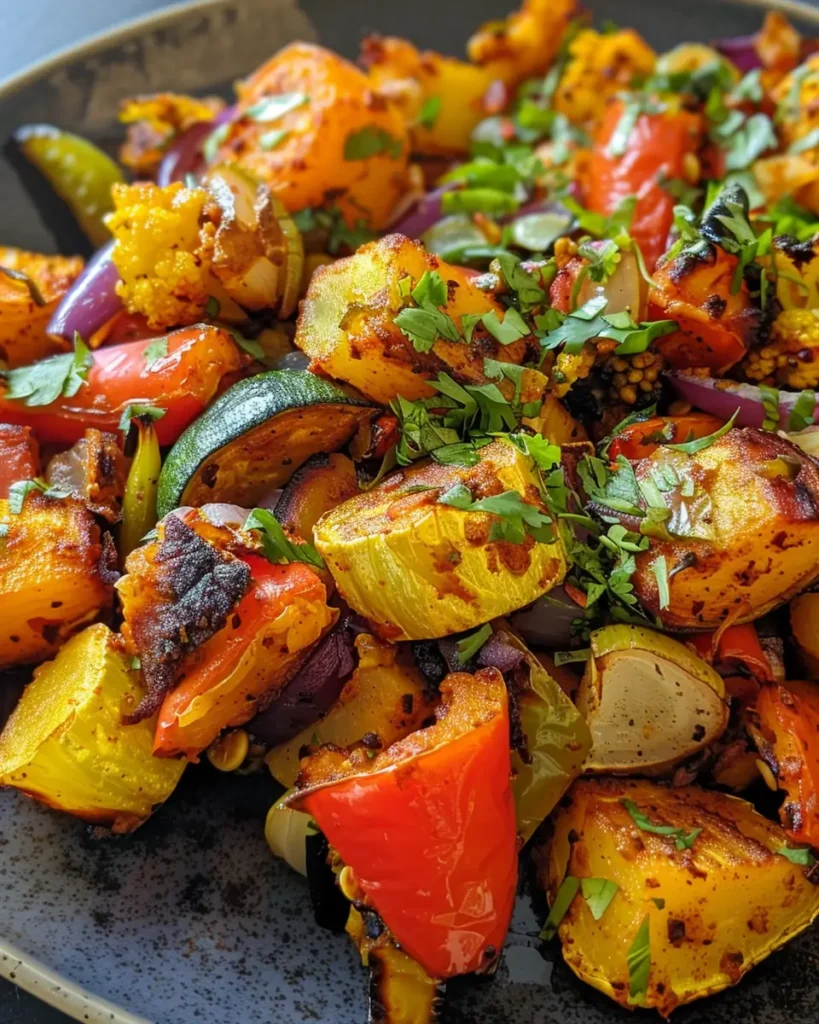
Make your meals more exciting by adding Indian cuisine flavors. It’s easy: pick your favorite veggies, mix them with spices, and roast until they’re perfect.
Table of Contents
Key Takeaways
- Learn how to flavor vegetables with Indian spices.
- Discover the nutritional benefits of roasted vegetables.
- Understand the simplicity of preparing Indian-inspired dishes.
- Explore the cultural significance of spices in Indian cuisine.
- Find out how to make a delicious and healthy side dish.
The Magic of Indian Spices in Vegetable Dishes
Indian cuisine is famous for its spices, which add deep flavors to vegetable dishes. The art of mixing spices has been passed down for centuries. Each region in India has its own spice blends and cooking ways.
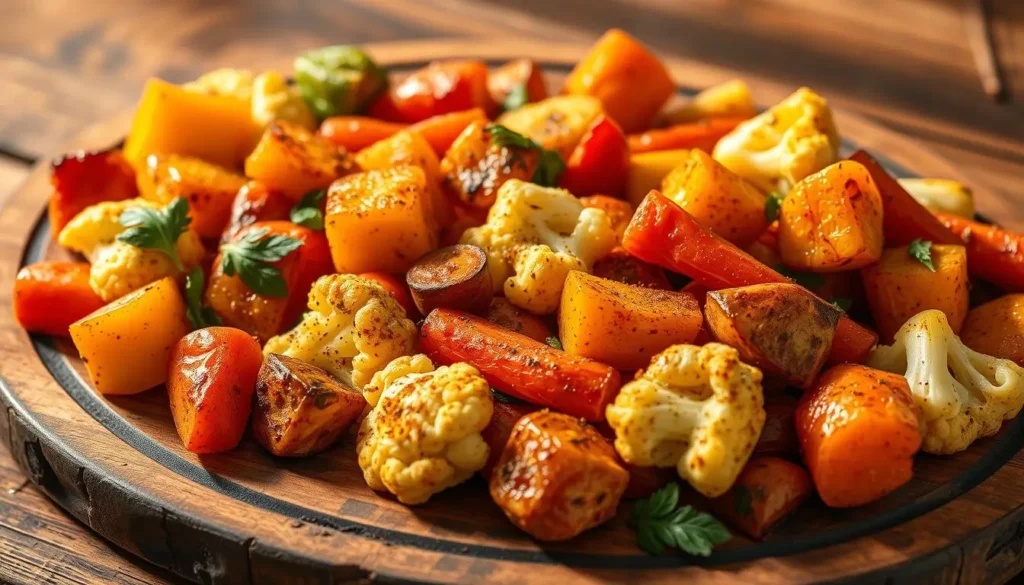
The Cultural Significance of Spices in Indian Cuisine
In Indian culture, spices are more than just flavor enhancers. They are believed to have healing powers and are used in Ayurvedic practices. Spices like turmeric, cumin, and coriander are common in many Indian homes. They are key to making vegetarian curries indian dishes.
| Spice | Culinary Use | Health Benefit |
|---|---|---|
| Turmeric | Adds color and warmth to dishes | Anti-inflammatory properties |
| Cumin | Enhances flavor in curries and stews | Aids digestion |
| Coriander | Used in a variety of dishes for its citrusy flavor | Rich in antioxidants |
Health Benefits of Indian Spices
Indian spices do more than just flavor food. They also have health benefits. Spices like turmeric and cumin help fight inflammation and aid digestion. Adding these spices to indian spiced vegetables and other dishes can make your meals healthier. Spices like coriander are also full of antioxidants, making them great for indian sides vegetable dishes.
Using a variety of Indian spices in your cooking can make your meals both tasty and nutritious. Whether you’re making a simple vegetable dish or a complex curry, the right spices can take your cooking to the next level.
Essential Ingredients for Indian Spiced Roasted Vegetables
Indian Spiced Roasted Vegetables is a dish that loves variety. You can try different vegetables and spice mixes to find your favorite. This makes the recipe very flexible and fun to play with.
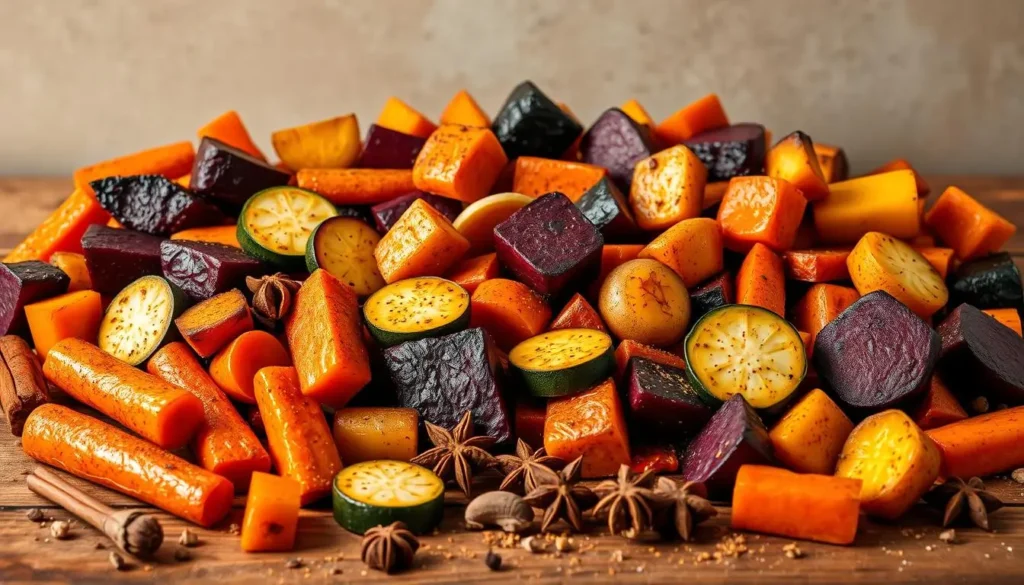
Selecting the Right Vegetables
Choosing the right vegetables is key for great taste and texture. You can pick one type or mix them. Carrots, cauliflower, bell peppers, and sweet potatoes are popular choices.
For something different, try lotus root or purple yam. Pick vegetables that are in season and fresh.
Think about how long each vegetable takes to roast. Carrots and sweet potatoes need more time than bell peppers and zucchini.
Must-Have Indian Spices for Roasting
The spice blend is what makes Indian Spiced Roasted Vegetables special. You’ll need turmeric, cumin, coriander, and garam masala. These spices add flavor and health benefits. For a spicy touch, add red chili powder or cayenne pepper.
Don’t be afraid to mix up the spices. A bit of smoked paprika can add a smoky taste, like in “curry roasted vegetables.”
Additional Aromatics and Herbs
Adding more aromatics and herbs can make your dish even better. Try garlic, ginger, or onions for extra depth. Sprinkle cilantro or parsley on top for freshness.
For a richer taste, use butter or ghee. These are common in “butter vegetables indian.” They make the vegetables taste luxurious and feel creamy.
Equipment You’ll Need
To get the best results with Indian Spiced Roasted Vegetables, you need the right tools. The right equipment makes preparing the vegetables easier. It also helps ensure they are roasted perfectly.
Baking Sheets and Roasting Pans
A high-quality baking sheet or roasting pan is key for roasting veggies. Heavy-duty, dark-colored pans are best because they spread heat evenly. This helps your veggies roast nicely. Make sure your pan is big enough to fit all the veggies in one layer. This lets air circulate well.
| Equipment | Description | Benefits |
|---|---|---|
| Baking Sheets | Large, flat, and often made of metal | Allows for even roasting and browning |
| Roasting Pans | Deeper than baking sheets, with handles | Easy to maneuver and can hold more vegetables |
Spice Grinders and Other Helpful Tools
A spice grinder is essential for grinding spices fresh. This is key for the flavor of your Indian Spiced Roasted Vegetables. Also, having a good quality knife for chopping and a mixing bowl for tossing veggies with spices makes prep easier.
Preparing Your Vegetables
To make your Indian spiced roasted vegetables the best, start with good preparation. This means cleaning, cutting, and treating them right to bring out their flavors.
Washing and Cutting Techniques
First, wash your vegetables well. This gets rid of dirt, pesticides, and other bad stuff. Use cold water and a soft brush for root veggies like carrots and potatoes. For leafy greens, a gentle soak in water helps remove dirt.
After washing, cut your veggies into the right sizes and shapes. The way you cut them affects how they roast. For example, cutting them evenly helps them roast the same. Cauliflower and broccoli can be cut into florets, while carrots and potatoes into wedges or cubes.
| Vegetable | Recommended Cut | Roasting Time |
|---|---|---|
| Carrots | Wedges or sticks | 25-30 minutes |
| Cauliflower | Florets | 20-25 minutes |
| Potatoes | Cubes or wedges | 30-35 minutes |
Pre-Roasting Treatments
Some veggies do better with a pre-roasting treatment. Blanching broccoli or cauliflower before roasting keeps them colorful and tender. Just boil them briefly, then cool them down in ice water.
Marination Methods
Marinating your veggies before roasting adds a lot of flavor. Mix yogurt, lemon juice, and spices like cumin and coriander for a marinade. Coat your veggies well and let them sit for 30 minutes to an hour before roasting.
By following these steps, your Indian spiced roasted vegetables will be tasty and look great. The right prep and treatment make the dish a hit at any meal.
Creating the Perfect Indian Spice Blend
To make authentic Indian spiced roasted vegetables, mastering the perfect spice blend is key. The right blend can make your vegetables taste amazing. In Indian cooking, spice blends are more than just mixing spices. They’re about finding a balance that brings out the best in your ingredients.
Basic Masala for Roasted Vegetables
A basic masala for roasted vegetables includes ground spices like cumin, coriander, garam masala, turmeric, and chili powder. These spices give your vegetables a warm, aromatic taste. You can change the amounts of these spices to fit your taste and the vegetables you’re using.
For example, cumin and coriander are great for cauliflower or carrots. But for bell peppers or zucchini, garam masala and paprika add a sweeter, smokier flavor.
Regional Variations of Spice Blends
Indian cuisine is very diverse, with different regions having their own spice blends. North Indian cuisine often has richer, more robust blends with lots of garam masala and cumin. South Indian cuisine, on the other hand, uses more chili peppers, mustard seeds, and curry leaves for a unique taste.
Knowing these regional differences lets you try different spice blends. You might find that a South Indian-inspired blend adds a great twist to your roasted vegetables.
| Region | Key Spices | Flavor Profile |
|---|---|---|
| North Indian | Garam Masala, Cumin, Coriander | Rich, Robust |
| South Indian | Chili Peppers, Mustard Seeds, Curry Leaves | Spicy, Aromatic |
| East Indian | Mustard Oil, Panch Phoron | Distinctive, Pungent |
Adjusting Spice Levels for Your Preference
One of the best things about cooking with spice blends is adjusting the spice levels to your liking. If you prefer a milder flavor, reduce or omit chili powder. For a spicier taste, add more chili powder or diced jalapeños.
Remember to taste as you go and adjust the seasoning. This ensures your Indian spiced roasted vegetables are always delicious and just right for you.
Step-by-Step Guide to Indian Spiced Roasted Vegetables
Roasting vegetables with Indian spices is easy when you break it down. This guide will show you how to make the spice mix, coat the veggies, and roast them perfectly. You’ll learn about the right times and temperatures for the best results.
Preparing the Spice Mixture
The key to tasty curry roasted vegetables is the spice mix. You’ll need ground spices like turmeric, cumin, coriander, and garam masala. Add salt and any other spices you like. Grind these spices together until they’re well mixed and smell great.
You can change the spice amounts to suit your taste and the veggies you’re using.
Coating the Vegetables
Now, coat your Indian sides vegetable with the spice mix. Toss the veggies in a bowl with some oil and sprinkle the spice mix over them. Mix well so the veggies are evenly coated. The oil helps the spices stick to the veggies, making them taste great.
Arranging for Optimal Roasting
Put the coated veggies in a single layer on a baking sheet or roasting pan. This ensures even roasting. Don’t overcrowd the pan, as it can steam instead of roast. Use multiple pans if needed to give the veggies enough space.
Roasting Times and Temperatures
The roasting time and temperature depend on the veggies. A hot oven (around 425°F or 220°C) is best. Roasting time can be 20 to 40 minutes, based on the veggie’s density and how done you like them. Check on the veggies and toss them halfway to get even browning.
By following these steps, you can make a delicious Indian spiced roasted vegetables dish. It’s great as a side or main course. Try different spice blends and veggies to find your favorites.
Common Mistakes to Avoid
To get perfect Indian Spiced Roasted Vegetables, avoid common mistakes. Roasting is a simple yet detailed cooking method. It needs careful attention.
Overcrowding the Pan
One big mistake is overcrowding the roasting pan. When veggies are too close, they steam instead of roast. This makes them soggy. To fix this, spread veggies out in a single layer. Use multiple pans if needed.
Spice-Related Pitfalls
Another mistake is using spices wrong. Too much or too little spice can change the flavor a lot. For example, too much cayenne can overpower, while too little might make it bland. It’s better to start with a small amount and adjust as needed.
Temperature and Timing Issues
Wrong temperature and timing are also common problems. Roasting too low can make veggies undercooked or soggy. Roasting too high can burn them. Also, roasting for too long or too short can mess up texture and flavor. Here’s a guide for the best roasting conditions:
| Vegetable Type | Optimal Temperature (°F) | Roasting Time (minutes) |
|---|---|---|
| Root Vegetables | 425 | 25-35 |
| Cruciferous Vegetables | 400 | 20-25 |
| Soft Vegetables | 400 | 15-20 |
By avoiding these mistakes, you can make your Indian Spiced Roasted Vegetables much better. For more ideas, try thai roasted vegetables or butter vegetables indian. They can add variety to your cooking.
Vegetable-Specific Tips for Indian Spiced Roasted Vegetables
To get the best Indian Spiced Roasted Vegetables, knowing what each vegetable needs is key. Different veggies roast and soak up spice flavors in their own way.
Root Vegetables
Roots like carrots, beets, and sweet potatoes are dense. They need longer to roast. Cutting them evenly helps them cook the same.
Using a bit higher heat can make their sugars caramelize. This boosts their taste when mixed with Indian spices.
Cruciferous Vegetables
Vegetables like broccoli, cauliflower, and Brussels sprouts are different. They need a bit more heat to get a nice char. But, watch the time to keep them tender.
Soft Vegetables and Squashes
Soft veggies like bell peppers, zucchini, and squashes cook fast. They can get mushy if roasted too long. Use the right spice blend and roast at a moderate heat to keep them firm.
Knowing what each veggie needs lets you roast them perfectly. This way, every veggie is cooked just right and full of Indian spice flavor.
- Root Vegetables: Cut into uniform pieces and roast at a higher temperature for caramelization.
- Cruciferous Vegetables: Roast at high heat for a nice char, but be mindful of the timing.
- Soft Vegetables and Squashes: Roast at moderate temperatures to preserve texture.
Serving Suggestions for Indian Spiced Roasted Vegetables
Indian Spiced Roasted Vegetables offer endless serving options. We’ll help you explore both traditional and fusion ideas.
Traditional Indian Accompaniments
These vegetables go great with many Indian dishes. Serve them with Basmati rice or roti, naan, or other bread. A raita (yogurt with cucumber, cumin, and coriander) adds a cool touch.
For a bigger meal, pair them with dal (lentil soup) or in a thali (a balanced meal).
Fusion Serving Ideas
Feel adventurous? Add Indian Spiced Roasted Vegetables to non-Indian dishes. They’re great as a side with grilled meats or on salads and wraps. They also make a tasty filling for vegetarian quesadillas or a pizza topping.
Garnishing for Visual Appeal
Make your dish look appealing. Top with fresh herbs like cilantro or parsley. Add a sprinkle of sumac or paprika for color. A dollop of yogurt or creme fraiche adds creaminess.
Incorporating Indian Spiced Roasted Vegetables into Complete Meals
Indian Spiced Roasted Vegetables are great for many dishes. They fit well in both traditional Indian meals and modern recipes. This makes them a valuable addition to your cooking.
As Part of an Indian Thali
Adding Indian Spiced Roasted Vegetables to an Indian thali is a smart move. A thali has a main dish, sides, and extras. You can serve the roasted veggies with vegetarian curries, dal, and rice or roti.
For example, pair them with chana masala or palak paneer. These veggies add texture and taste to your thali. They make your meal more satisfying and balanced.
| Dish | Description | Pairing Suggestion |
|---|---|---|
| Indian Spiced Roasted Vegetables | Roasted vegetables seasoned with Indian spices | Serve with dal and rice |
| Chana Masala | Chickpeas cooked in a spicy tomato-based sauce | Pair with roti or rice |
| Palak Paneer | Spinach curry with paneer (Indian cheese) | Complement with naan or rice |
In Western-Style Meals
Indian Spiced Roasted Vegetables are also great in Western dishes. They add flavor and nutrition. You can serve them as a side or as a topping for salads and sandwiches.
For example, pair them with roasted chicken or grilled steak. They make your meal more flavorful. Or, use them as a topping for a salad or wrap. This adds a healthy twist to your meal.
Regional Variations of Indian Spiced Roasted Vegetables
Indian Spiced Roasted Vegetables vary greatly across the country. From the Himalayas to the south, each region adds its own twist. This variety is what makes Indian cuisine so rich and diverse.
North Indian Style
North Indian food is famous for its creamy sauces and bold spices. For Indian Spiced Roasted Vegetables, North Indians marinate veggies in yogurt and spices. This makes the dish both flavorful and aromatic.
South Indian Variations
South Indian food is simpler, focusing on fresh ingredients and fewer spices. Curry roasted vegetables here often include coconut and chilies. This adds a tangy and spicy taste.
East and West Indian Approaches
In Eastern India, like Bengal, mustard oil and special spices are key. This gives Indian Spiced Roasted Vegetables a unique taste. Western India, like Gujarat, uses jaggery and spices for a sweet and savory mix. This approach balances flavors, making the dish complex and tasty.
These regional differences highlight the diversity of Indian cuisine. They also inspire home cooks to try new curry roasted vegetables and other Indian dishes.
Storing and Reheating Tips
To enjoy your Indian Spiced Roasted Vegetables for longer, proper storage and reheating are key. This keeps the flavors and textures fresh, so you can enjoy it more times.
Storing your roasted vegetables right is important. Here are some tips:
Proper Storage Methods
- Cool the roasted vegetables completely before storing them in airtight containers.
- Use containers that are safe for refrigerator storage to prevent contamination.
- Label the containers with the date to keep track of how long they’ve been stored.
Roasted vegetables can stay fresh in the fridge for 3-5 days. For longer, freezing is a good option.
Best Practices for Reheating
Reheating your Indian Spiced Roasted Vegetables right is as important as storing them. Here are some tips:
- Reheat the vegetables in the oven at a moderate temperature (around 350°F) until they’re warmed through.
- Or, you can reheat them in a microwave-safe container, covering it with a microwave-safe lid or plastic wrap to keep moisture in.
By following these tips, you can enjoy your
Conclusion
You now have the tools and knowledge to make delicious Indian Spiced Roasted Vegetables. These can make any meal better. By using the right Indian spices and following the steps, you get a tasty, healthy dish.
Indian Spiced Roasted Vegetables are great for adding flavor to your meals. They’re perfect for daily dishes or special occasions. Try different spice mixes and veggies to make your own unique dishes.
With the tips and techniques we shared, you’re all set to start roasting. Enjoy the rich flavors of Indian cuisine right in your kitchen.
FAQ
What are Indian Spiced Roasted Vegetables?
Indian Spiced Roasted Vegetables are a tasty and healthy dish. They are made by roasting different vegetables with Indian spices. The spices used can vary based on where you are from and your personal taste.
How do I choose the right vegetables for Indian Spiced Roasted Vegetables?
Pick a mix of vegetables like cauliflower, carrots, bell peppers, and potatoes. Choose ones with different textures and colors. This makes the dish look good too.
What are the essential Indian spices for roasting vegetables?
Key spices include turmeric, cumin, coriander, garam masala, and chili powder or cayenne pepper. You can change the spice amount to suit your taste for heat and flavor.
Can I use pre-ground spices for Indian Spiced Roasted Vegetables?
Pre-ground spices are easy to use, but grinding spices fresh can make your dish taste better. Try using a spice grinder to grind whole spices.
How do I prevent overcrowding the pan when roasting vegetables?
Spread the vegetables out in a single layer on the baking sheet. You might need more than one sheet, depending on how many vegetables you have.
What is the ideal temperature for roasting Indian Spiced Vegetables?
Roast at a temperature between 425°F to 450°F (220°C to 230°C). This helps the vegetables get a nice caramelized look.
How can I store and reheat Indian Spiced Roasted Vegetables?
Keep the roasted vegetables in an airtight container in the fridge for up to 3 days. Reheat in the oven or microwave until warm. Add a bit of water if needed to keep them moist.
Can I make Indian Spiced Roasted Vegetables ahead of time?
Yes, you can prepare the spice mix and chop the veggies ahead. Store them in separate airtight containers until you’re ready to roast.
Are Indian Spiced Roasted Vegetables suitable for a vegan diet?
Yes, they are vegan if you don’t add dairy or honey. Make sure your spice blends don’t have animal products either.
How can I adjust the spice level in Indian Spiced Roasted Vegetables?
To change the spice level, add more or less chili powder or cayenne pepper. You can also reduce spices for a milder taste.
What are some common mistakes to avoid when making Indian Spiced Roasted Vegetables?
Avoid overcrowding the pan, not adjusting spice levels, and not watching the roasting time and temperature. This can lead to undercooked or burnt veggies.
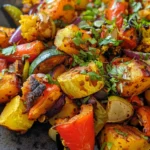
Indian Spiced Roasted Vegetables
Ingredients
Vegetables
- 2 cups Carrots, chopped Cut into wedges or sticks
- 2 cups Cauliflower florets Break into bite-sized pieces
- 2 cups Bell peppers, diced Any color will work
- 2 cups Sweet potatoes, cubed Peel and cut into even cubes
Spice Mix
- 1 teaspoon Turmeric powder
- 1 teaspoon Cumin powder
- 1 teaspoon Coriander powder
- 1 teaspoon Garam masala
- ½ teaspoon Red chili powder Or adjust to taste
Other Ingredients
- 3 tablespoons Olive oil For tossing vegetables
- 1 teaspoon Salt To taste
- ¼ cup Fresh cilantro, chopped For garnishing
Instructions
Preparation
- Preheat the oven to 425°F (220°C).
- Wash and prepare the vegetables, cutting them into uniform sizes for even roasting.
- In a large mixing bowl, combine the vegetables with olive oil, salt, and the spice mix.
- Toss the vegetables until evenly coated with oil and spices.
Roasting
- Spread the coated vegetables in a single layer on a baking sheet.
- Roast in the preheated oven for 25-30 minutes, stirring halfway through, until golden and tender.
Serving
- Remove from the oven, and let cool slightly before garnishing with fresh cilantro.
- Serve warm as a side dish or as part of a larger meal.
